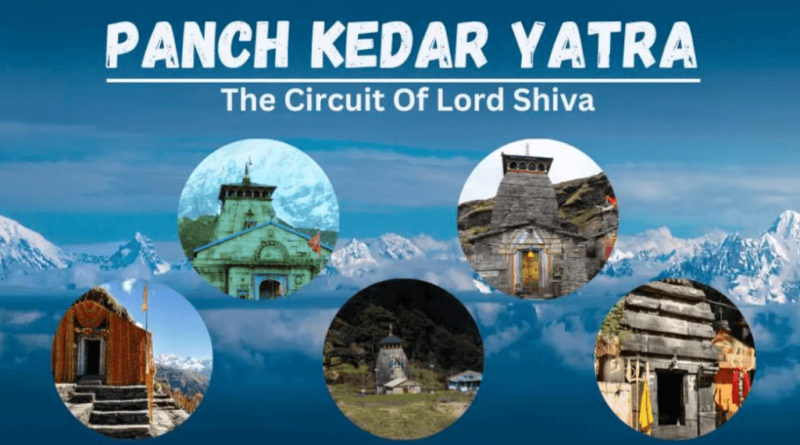Panch Kedar Yatra Travel Guide
1. Overview of the Panch Kedar
The Panch Kedar refers to five temples dedicated to Lord Shiva, each representing a different part of the deity’s body. These temples are:
- Kedarnath: Represents the hump of Lord Shiva.
- Tungnath: Represents the arms of Lord Shiva.
- Rudranath: Represents the face of Lord Shiva.
- Madhyamaheshwar: Represents the navel of Lord Shiva.
- Kalpeshwar: Represents the hair of Lord Shiva.
The yatra typically starts from Kedarnath and moves in a specific sequence, though the order may vary based on logistics and personal preference.
2. Best Time to Visit
The ideal time for the Panch Kedar Yatra is from late April to early November. The winter months bring heavy snowfall to the region, making travel difficult and dangerous. The summer months offer clear skies and manageable temperatures, but it’s crucial to check weather conditions before setting out.
3. Preparation for the Yatra
Physical Preparation: The trek to each of the Panch Kedar temples can be strenuous. It’s advisable to be in good physical condition. Regular trekking, hiking, or cardiovascular exercises can be beneficial.
Permits and Documentation: Ensure you have all necessary permits and identification. While Indian citizens usually don’t require special permits, foreign nationals should check with local authorities or travel agencies.
Packing List: Essential items include:
- Warm clothing and layers (weather can be unpredictable)
- Comfortable trekking shoes
- A walking stick
- Rain gear (umbrella, raincoat)
- Personal medication
- High-energy snacks and water bottles
- Sunscreen and sunglasses
Health Precautions: Acclimatization is crucial to prevent altitude sickness. Spend a day or two in lower altitudes before ascending. Carry medication for altitude sickness, and consult with a physician before the journey.
4. Itinerary Overview
Day 1-2: Kedarnath
- Getting There: Kedarnath is accessible by a 16 km trek from Gaurikund or by helicopter (seasonal availability). The trek can take around 6-8 hours, depending on pace.
- Highlights: Kedarnath is situated at an altitude of 3,583 meters and offers stunning views of the surrounding peaks. The temple is open from late April to early November.
- Accommodation: Options range from basic lodges to guesthouses. It’s advisable to book in advance during peak season.
Day 3-4: Tungnath
- Travel: From Kedarnath, travel to Chopta, which is the base for the Tungnath trek. This journey involves a drive of approximately 200 km.
- Trek: The 3.5 km trek from Chopta to Tungnath takes about 2-3 hours.
- Highlights: Tungnath is the highest of the Panch Kedar temples, situated at 3,680 meters. The trek offers panoramic views of the surrounding Himalayan ranges.
- Accommodation: Basic lodging is available in Chopta. Advance booking is recommended.
Day 5-6: Rudranath
- Travel: From Tungnath, travel to the village of Sagar, which is the starting point for the Rudranath trek. The journey involves a combination of road and trek.
- Trek: The trek to Rudranath is challenging and takes about 2-3 days, covering approximately 20 km.
- Highlights: Rudranath is located at an altitude of 2,286 meters and is surrounded by dense forests and meadows. The temple is noted for its serene and secluded location.
- Accommodation: Basic guesthouses are available in the nearby areas. Camping might be an option for those who prefer it.
Day 7-8: Madhyamaheshwar
- Travel: From Rudranath, travel to the base camp at the village of Uniana.
- Trek: The trek to Madhyamaheshwar takes around 5-6 hours, covering approximately 12 km.
- Highlights: Located at 3,289 meters, Madhyamaheshwar is situated in a picturesque valley. The temple offers stunning views and a peaceful atmosphere.
- Accommodation: Simple lodges or guesthouses are available near the base camp.
Day 9-10: Kalpeshwar
- Travel: From Madhyamaheshwar, travel to the village of Helang, which is the starting point for the Kalpeshwar trek.
- Trek: The trek to Kalpeshwar is relatively short, taking around 2-3 hours.
- Highlights: Kalpeshwar, at 2,200 meters, is known for its natural beauty and the ancient cave temple. It’s the final destination in the Panch Kedar circuit.
- Accommodation: Basic accommodation options are available in the nearby villages.
5. Cultural and Spiritual Aspects
Significance: Each temple of the Panch Kedar holds a unique significance in Hindu mythology. Visiting these temples is believed to cleanse sins and bestow divine blessings.
Local Customs: Respect local customs and traditions. When visiting temples, dress modestly and follow the etiquette. Photography is often restricted inside temples.
Local Cuisine: Enjoy local Garhwali cuisine, which includes dishes like Aloo ke Gutke, Phaanu, and Gahat ki Dal. It’s a good idea to carry some ready-to-eat food and snacks as options may be limited in remote areas.
Interaction with Locals: The people of Uttarakhand are known for their hospitality. Engage with local communities, learn about their culture, and support local artisans and businesses.
6. Safety Tips
- Weather Conditions: Check weather forecasts regularly and be prepared for sudden changes.
- Altitude Sickness: Acclimatize properly and be aware of symptoms. Seek medical help if needed.
- Wildlife: While encounters with wildlife are rare, be cautious and avoid feeding or disturbing animals.
- Emergency Services: Know the location of the nearest medical facilities and keep emergency contact numbers handy.
7. Conclusion
The Panch Kedar Yatra is more than just a pilgrimage; it’s a journey through some of the most breathtaking landscapes in India. It offers spiritual solace, physical challenge, and a deep connection with nature and divinity. With proper planning and preparation, this yatra can be a life-changing experience, combining adventure with spirituality in the heart of the Himalayas.
Whether you’re a devout pilgrim or an adventurous traveler, the Panch Kedar Yatra promises a unique and enriching experience. Embrace the journey, respect the traditions, and let the divine aura of the Panch Kedar temples guide you on this sacred path.




